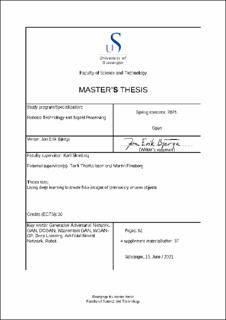| dc.description.abstract | Deep learning artificial neural networks are implemented in machines at an increasing rate in
order to make them think and act the human way. A popular use of these neural networks
is in object detection software, making the machines able to know their environment. A
problem is that the training of the neural network requires manual effort, in order to create
the training dataset.
Will advances in the training of Generative models, with the introduction of adversarial
training be able to reduce this manual effort? This thesis explores if (assesses how) the Generative Adversarial Networks (GAN) model can be used to supplement a training dataset
without the manual registration effort.
The main focus is the Deep Convolutional Generative Adversarial Network (DCGAN) and
the Wasserstein Generative Adversarial Network with Gradient Penalty (WGAN-GP) versions of GANs. The thesis includes the theoretical background and some practical implementation issues for experimenting with these GAN variants.
Three main experiments are presented. First, testing how these generative networks perform on a dataset of images with boxes containing objects with different orientations and
positions. Second, experimenting with only a limited amount of images used for training,
before testing two proposed improvement methods, pre-training the models and expanding
the dataset with the generated (artificial) images. For the last experiment the object detection software will be tested on the generated images.
The results show that it is possible to use Generative Adversarial Networks to generate new
additional images for a limited dataset. Perhaps not impressing, but nevertheless, up to
4 % of the generated artificial images have the sufficient quality to be considered as new
additions to the dataset. | |
